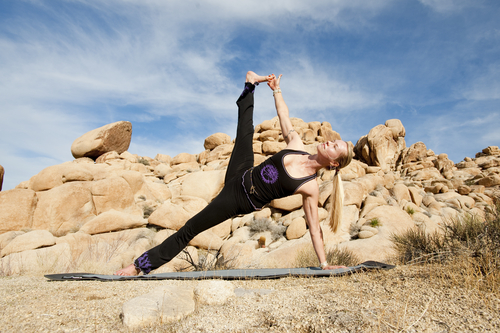The Sanskrit word that describes yoga posture is asana. But only three out of the 196 verses in the Yoga Sutras (the fundamental text on the philosophy and practice of yoga) deal with asana.
Within those verses, a fundamental principle is imparted. It’s a principle missing from most classes today, and it’s one that when left out can cause both minor and major harm.
The sutra (sutra 2.46) reads, “Sthira sukham asanam.” This is basically translated as, “Asana is a steady, comfortable posture.” This sutra should be every yogis guiding star in the practice of postures. Let’s consider why practicing asana without this instruction is so damaging and why practicing with it is fraught with promise.
Finding Balance Through Self-Study
For the longest time, this sutra perplexed me. The yoga practice I was accustomed to doing was anything but comfortable. Steady? Sometimes, yes. But comfortable? No way.
Then I started studying with a teacher who helped me feel the balance referred by this sutra within my own body. Through that work, as well as my own svadhyaya (self-study), which included reading various translations of and commentaries on the yoga sutras and contemplating the natural world, it all came together for me.
“For the longest time, this sutra perplexed me. The yoga practice I was accustomed to doing was anything but comfortable. Steady? Sometimes, yes. But comfortable? No way.”
What’s being referred to in the sutra is a balance of energy. Keep in mind, I’m not using the word “energy” in any kind of new-age sense. I’m talking about tangible forces at work in the body.
The branch of yoga most commonly practiced today is hatha yoga. The word hatha refers to the balancing of opposites. Ha being the sun, or masculine energy, and tha being the moon, or feminine energy. The original intent of hatha yoga was to refine the balance of opposites within each individual (masculine/feminine, strength/flexibility, intuition/reason, etc.). Students experience this balance as a greater sense of wholeness and overall well-being. This balance can only be found by honoring the basic principle of asana.
Midline Energy
So with well-being as our goal, let’s look at a few ways you can begin to feel this energetic balance within yourself. Then, if you go into a class focused on poses rather than principle, you will know how to take care of yourself.
It’s really all about the core. But not the core as you may have come to think of it. It’s common in the fitness world to think of the core as the lower abdominal region. Something I learned in a workshop with anatomy expert Leslie Kaminoff changed forever the way I understand the core. He taught us that the core is that which is closest to the bone. It involves the entire body.

In my classes, I’ve come to use the term “midline energy” to instruct students on how to connect with their core or center. This term has proven accessible and the body responds to it. An awareness of the midline energy of the body is designed to keep the practitioner from holding back or going too far because they are disconnected from their center. In other words, it provides stability – the sthira aspect of the asana equation.
Here are a couple simple ways to experience what I’m referring to:
- Stand with your feet parallel.
- Reach your arms out to the side, level with your shoulders.
- Make sure your hands face forward.
- Reach out as far as you can. Even reach so far that your shoulder blades begin to separate.
- Now, begin to pull in by drawing your arm bones back into the shoulder sockets. Don’t lessen the outward reach. Just create the inward pull to balance it.
Hopefully, you can feel how this counterbalance would keep you from overextending yourself. This same energy dynamic of balancing your outward reach with your inward reach can be applied to different parts of the body.
“An awareness of the midline energy of the body is designed to keep the practitioner from holding back or going too far because they are disconnected from their center.”
Another way many of us lose our center is by letting our bottom front ribs push forward and/or allowing the tailbone and low-back area to arch back. A simple way to keep this tendency in check is to shorten the space between your bottom front ribs and your navel.
- Stand with your feet parallel.
- Feel what’s happening in your rib cage and pelvic areas.
- Bring your fingers on either sides of your navel and your thumbs on the bottom front ribs.
- Use your hands to draw the navel up and your thumbs to draw the bottom front ribs down. This will reduce the space between the ribs and the belly button and cause your tailbone and buttocks to lengthen down.
Now you’re connected to core or midline energy. This stable foundation provides a container for your freedom. Start bringing mindfulness to these actions in class and your practice will never be the same.

Be Your Own Teacher
When you become attuned to the sophisticated energetic balance within you, you become your own teacher. Instead of unconsciously reinforcing old patterns, you set out on a constant journey of awakening externally and internally. This awakening will spill off your mat and into your whole life.
“Instead of unconsciously reinforcing old patterns, you set out on a constant journey of awakening externally and internally.”
What I’ve shared here combined with self-study of the yoga sutras, nature, and your own body/mind, will enable you to maintain your equilibrium in any yoga class. You won’t be counted among those sustaining injuries from their practice. You will sharpen your mind, heal your body, and expand your awareness. You will understand you’re not just doing yoga poses – you’re exploring a living principle within your own body/mind.
This reacquainting with the whole of yoga allows us to reap the promised benefits described in the last two sutra verses that apply to asana:
As the body yields all efforts and holdings, the infinite within is revealed.
Thereafter, we are freed from the fluctuations of the gunas [the mind or duality].
It’s hard to believe the simplicity of balance brings such an extraordinary reward.
You’ll Also Enjoy:
- Your Yoga Crystal Ball: Stop Injuries Before They Happen
- Using Kundalini to Cultivate Awareness in Your Yoga Practice
- How to Maintain Yoga’s Lineage in Modern Times
- The Latest on Breaking Muscle Today
References:
1. Nischala Joy Devi, The Secret Power of Yoga. New York: Three Rivers Press, 2007.
2. Patanjali, Yoga Sutras of Patanjali. Translated by Sri Swami Satchidananda. Buckingham, VA: Integral Yoga Publications, 1978.
3. Leslie Kaminoff and Amy Matthews, Yoga Anatomy. United States: Human Kinetics, 2012.
4. Swami Swatmarama, Hatha Yoga Pradipika. Translated by Pancham Sinh, New Delhi: Dev Publishers & Distributors, 2013.
Photos courtesy of Shutterstock.






